Introduction
What Does The American Robin Eat: The American Robin, scientifically known as Turdus is an iconic and widespread bird species found throughout North America. Known for its distinctive appearance and melodious song, the American Robins territorial is a symbol of spring’s arrival in many parts of the continent. While its vibrant red breast and cheerful chirping are familiar to most, there is much to discover about this beloved bird’s dietary habits and feeding preferences. The American Robin’s diet is both diverse and adaptable, reflecting its ability to thrive in various habitats and seasons. These birds are primarily omnivorous, which means they consume a wide range of foods, including both animal and plant matter. Their dietary choices shift throughout the year, largely dictated by the changing seasons and food availability.
In the spring and summer months, when insects become abundant, American Robins rely heavily on a diet rich in insects and other invertebrates. They are skilled foragers, hopping along lawns, gardens, and wooded areas, searching for earthworms, caterpillars, beetles, and other small arthropods. They have a keen eye for spotting movement in the ground and a remarkable ability to extract worms from the soil with their sharp beaks. This insect-rich diet he essential protein and nutrients needed to support their breeding activities. As the seasons progress and fall approaches, American Robins shift their dietary focus towards fruits and berries. They play a vital role in dispersing seeds of various plant species, as they consume and then spread the seeds through their droppings.
This feeding behavior is particularly for the regeneration of plants and trees in the ecosystems they inhabit. They have a particular fondness for berries like holly, dogwood, and sumac, which are readily available in the autumn. During the winter months, when insect activity diminishes and fruits become scarce, American Robins adapt by switching to alternative food sources. They may rely on berries that persist through the winter or turn to crabapples and other ornamental trees, as well as food scraps found in human-populated areas. The American Robin eats is not only fascinating but also underscores their critical role in maintaining the balance of our ecosystems. These adaptable and resourceful birds are not only a delight to observe but also serve as a of the interconnectedness of all living beings in the natural world.
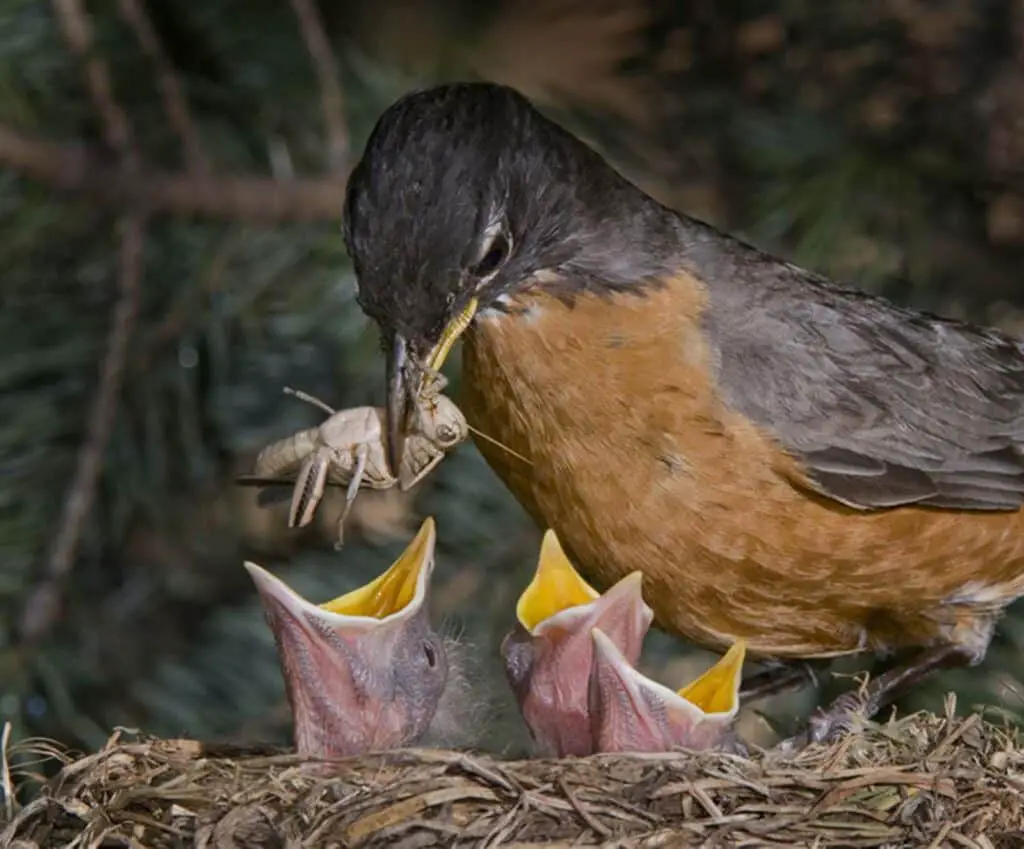
What is the best food to feed Robins?
If you’d like to attract robins at bird feeders, feed them chopped apples, berries and mealworms. They don’t eat birdseed. They prefer to forage for their food in lawns and open areas. Providing water is important for robins because they like to drink and bathe regularly.
Mealworms: Mealworms are a favorite treat for robins. They are rich in protein and easy for robins to digest, making them an excellent choice for supplementing their diet, especially during the breeding season when protein is crucial for chick development. You can offer live or dried mealworms, and they are readily available at bird supply stores.
Fruits: Robins have a penchant for a variety of fruits, including berries (e.g., blueberries, raspberries, and strawberries), sliced apples, pears, and raisins. Fruits essential vitamins and minerals while offering a sweet and juicy snack for robins. Ensure the fruits are fresh and free from mold, which can be harmful to birds.
Bird Seed Mix: While robins are primarily insectivorous, they do consume seeds occasionally. A bird seed mix that includes sunflower seeds, millet, and cracked corn can attract robins to your feeder, especially during the winter months when insects are less abundant.
Suet: Suet cakes or blocks are a great energy source for robins. They contain fats and proteins that are essential for their survival during cold weather. Suet can be placed in specialized suet feeders or offered in a mesh bag.
What fruit does Robin eat?
A Robin’s Favorite Winter Foods
Winter robins eat berries, other fruits, and seeds they find on shrubs, trees, and vines. If robins happen to overwinter near you, you can offer them frozen or fresh fruit. They’ll go for apple slices, raisins, blueberries, strawberries, raspberries, and cherries.
Berries are a favorite fruit for robins. They are often seen foraging in gardens, woodlands, and parks for these nutritious treats. These small, sweet berries are a popular choice for robins and are often found in their diet. Another favorite, raspberries a juicy and flavorful snack. Robins are known to pluck ripe strawberries from gardens when available.
These dark and juicy berries are relished by robins, particularly in late summer and early autumn. While not as common, elderberries are occasionally consumed by robins when they are ripe. Robins are known to enjoy apples, both in orchards and urban areas. They often peck at the flesh of apples to extract the juicy pulp.
Pears are another fruit that robins may eat, although they are less commonly consumed compared to berries and apples. Robins are known to eat cherries when they are in season. They may pluck the fruit from cherry trees or forage for fallen cherries on the ground. While not a natural part of their diet, robins may sample grapes if they are available in gardens or vineyards.
It’s that robins are seasonal fruit consumers. They are more likely to include fruits in their diet during the late summer and autumn months when many fruits are ripe and abundant. Fruits robins with essential vitamins, minerals, and carbohydrates, making them a valuable food source, especially as they prepare for migration or endure the challenges of winter.
How much food does a robin eat?
These birds are attracted to open lawns and gardens with mature shrubbery and trees. While they eat a variety of insects and berries, it has been noted that they can eat up to 14 feet of earthworms in a day!
Spring and Summer: During the breeding season, robins increase their food intake significantly. They need extra energy and nutrients to support egg-laying, incubation, and feeding their growing chicks. At this time, a single robin may need to consume the equivalent of its own body weight in food each day. This can include a diet rich in insects, earthworms, and other invertebrates, which essential protein for breeding success.
Fall: As summer transitions to fall, robins shift their diet towards fruits and berries. They often consume these high-energy foods to prepare for migration or to build up fat reserves for the winter. The amount of fruit they eat can vary, but it’s not uncommon for them to consume several berries or fruits in a short period to meet their energy needs.
Winter: In colder regions, where insects and berries become scarce, robins may rely on alternative food sources. During winter, their food intake decreases as they enter a state of torpor, a sort of hibernation-lite, to conserve energy. They may occasionally visit bird feeders for suet, nuts, or seeds, but their overall intake is reduced compared to the warmer months.
What do baby robins eat?
For the first four days of a nestling’s life, the parent birds regurgitate partly digested food into each baby’s mouth. By five days of age, the nestlings get earthworms that parents break into small mouthfuls. The babies eat more each day. Soon parents give them whole worms and large insects.
Regurgitated Food: Adult robins actively hunt for insects and forage for food to feed their nestlings. They capture insects and then regurgitate partially digested food into the mouths of their hungry chicks. This process ensures that the young birds receive the necessary nutrients in a form they can digest easily.
Parental Care: Both the male and female robins take turns caring for their chicks and providing them with a constant supply of food. They feed their offspring numerous times throughout the day, as the rapid growth of nestlings demands a consistent source of nourishment.
Growth Phases: As baby robins grow, their dietary needs evolve. Initially, they require soft and easily digestible insects, but as they get older and their beaks become stronger, they can consume larger and more substantial prey items.
Transition to Fruits: As the baby robins near the time of fledging (leaving the nest), their diet may begin to include some fruits, mirroring the dietary shift observed in adult robins during late summer and early autumn. These fruits energy for the young birds as they prepare to leave the nest.
Why are robins so friendly?
As a gardener digs over the soil, robins stand by expectantly, hopping back and forth in between sitting and watching, their sparkly eyes looking for juicy worms to be uncovered. This helps to answer the age-old question: ‘why are robins so friendly? ‘ Well, there might just be some tasty morsels in it for them!
Tolerance of Humans: Robins have adapted well to human environments, including suburban areas and gardens. They have learned to coexist with people and often nest in close proximity to human dwellings. This frequent interaction with humans has made them more accustomed to human presence.
Curiosity: Robins are naturally curious birds. They may approach humans, especially if they are doing activities like gardening or digging, in the hope of finding insects or other food items unearthed by human activity. Their curiosity can make them seem friendlier as they investigate their surroundings.
Familiarity with Humans: In robins may become familiar with specific individuals who regularly food in bird feeders or gardens. This familiarity can lead to a perception of friendliness as robins become less skittish around those who offer them a reliable food source.
Interaction Through Bird Feeders: If you have bird feeders in your yard, you may notice robins visiting them. While they primarily feed on insects and fruits, they will occasionally partake in seed offerings. This interaction can make robins appear friendly, as they come close to observe and feed.
What is Robin’s favorite food one piece?
Robin’s favorite foods are sandwiches, not too sweet cakes, and stuff that goes with coffee. Also, her favorite food from Wano Country is soba. Her least favorite food is chewing gum because she can’t swallow it. Robin eats ice cubes, the same as Luffy, Usopp, Chopper and Brook.
High Nutritional Value: Earthworms are rich in protein, a vital nutrient for birds, especially during the breeding season. Protein is essential for developing the muscles and feathers of growing nestlings. Adult robins also need protein to maintain their own health.
Ease of Digestion: Earthworms are relatively easy for robins to digest, making them an efficient food source. This is especially for nestlings, which have developing digestive systems and need easily digestible food.
Abundance: Earthworms are widely distributed and can be found in various habitats, making them a reliable and readily available food source for robins. This abundance ensures that robins can find earthworms even in urban and suburban environments.
Active Foraging: Robins are skilled foragers and have adapted well to hunting earthworms. They have a keen eye for spotting movement in the ground and are adept at extracting earthworms from the soil with their sharp beaks.
What eats Robin eggs?
The main predators of robin eggs are blue jays, crows, snakes, squirrels. Deer eat a lot of bird eggs and nestlings, too, but only from ground nests. Snakes swallow eggs on the spot, and since you found one egg in the yard, a snake most certainly wasn’t the culprit.
Tree squirrels, such as gray squirrels and eastern fox squirrels, are known egg predators. They are agile climbers and can access robin nests in trees to pilfer eggs. Raccoons are skilled climbers and opportunistic feeders. They can easily raid robin nests, especially when they are low in the branches or located in tree cavities.
Some snake species, particularly those that can climb trees or reach into small cavities, may prey on robin eggs. Garter snakes and rat snakes are examples of snake species that may consume bird eggs. Birds in the corvid family, such as crows and jays, are omnivorous and opportunistic feeders. They may raid robin nests and consume both eggs and nestlings.
Blue jays, in particular, are known for their egg-eating habits. They are skilled at locating nests and removing eggs with their strong bills. Certain bird species, including blackbirds and grackles, are known to prey on robin eggs when given the opportunity.
In urban and suburban areas, domestic cats that are allowed to roam outdoors can pose a threat to nesting birds, including robins. Cats may climb trees or bushes to access nests. Some small mammals, like rats and mice, may occasionally consume robin eggs, particularly if they find unattended nests.
Do robins eat their eggs?
Breeding timeline
Once the clutch is complete, incubation is by the female alone for 13 days. The shells of the hatched eggs are removed immediately from the nest by the female, who sometimes eats part of them for extra calcium.
Inadequate Nest Building: If a robin’s nest is poorly constructed or unstable, there is a risk that eggs may be accidentally knocked out of the nest or damaged. This can occur due to strong winds, heavy rain, or the bird’s own movements within the nest.
Inexperienced Parents: Young or first-time parent robins may lack the experience needed to incubate and care for their eggs properly. In some cases, they may not sufficient warmth and protection, leading to egg damage or loss.
Nest Parasitism: Brown-headed cowbirds, a parasitic bird species, sometimes lay their eggs in the nests of other birds, including robins. When cowbird chicks hatch, they are often larger and more aggressive than robin nestlings. In response, the robin parents may remove the cowbird eggs from the nest to better care for their own offspring.
Predator Defense: In the presence of a predator or threat near the nest, robins may react by trying to remove or hide their eggs to protect them from potential harm. This behavior is more about safeguarding the eggs than intentionally eating them.
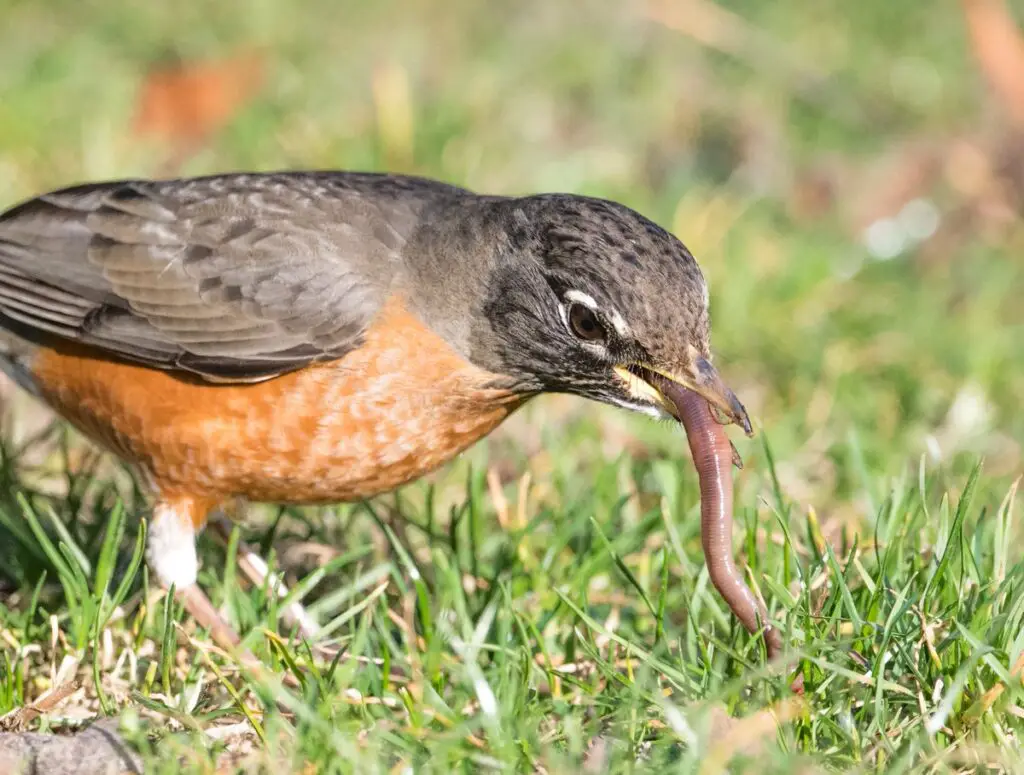
Conclusion
In the dietary habits of the American Robin exemplify the remarkable adaptability of this iconic North American bird species. Throughout the changing seasons, American Robins demonstrate a keen ability to shift their food preferences, showcasing their flexibility in response to the availability of various food sources. Their diet is a testament to their role as both consumers and contributors to the ecological balance of their habitats. During the breeding season, American Robins rely heavily on a diet of insects and invertebrates. Their exceptional foraging skills enable them to extract earthworms and other small arthropods from the ground, providing a vital source of protein and nutrients to support their reproductive efforts.
This insect-rich diet not only sustains their own populations but also helps control insect populations, making them valuable allies in pest management. As the seasons transition to autumn, American Robins undergo a dietary shift towards fruits and berries. They become crucial agents in the dispersal of seeds, aiding in the regeneration of various plant species. Their preference for specific berries like holly, dogwood, and sumac underscores their role in shaping the composition of local flora. By consuming and spreading seeds, they contribute to the resilience and diversity of their ecosystems.
During the winter months, when insects and ripe fruits become scarce, American Robins demonstrate resourcefulness by seeking out alternative food sources. They may feed on berries that persist through the winter or turn to ornamental trees and shrubs, as well as human food sources. This adaptability allows them to survive and endure harsh winter conditions when other food options are limited. The American Robin’s dietary habits not only reflect its ability to adapt but also highlight its significance in maintaining the delicate balance of ecosystems. As a flagship species of North American birdlife, they serve as a symbol of nature’s resilience and interconnectedness.

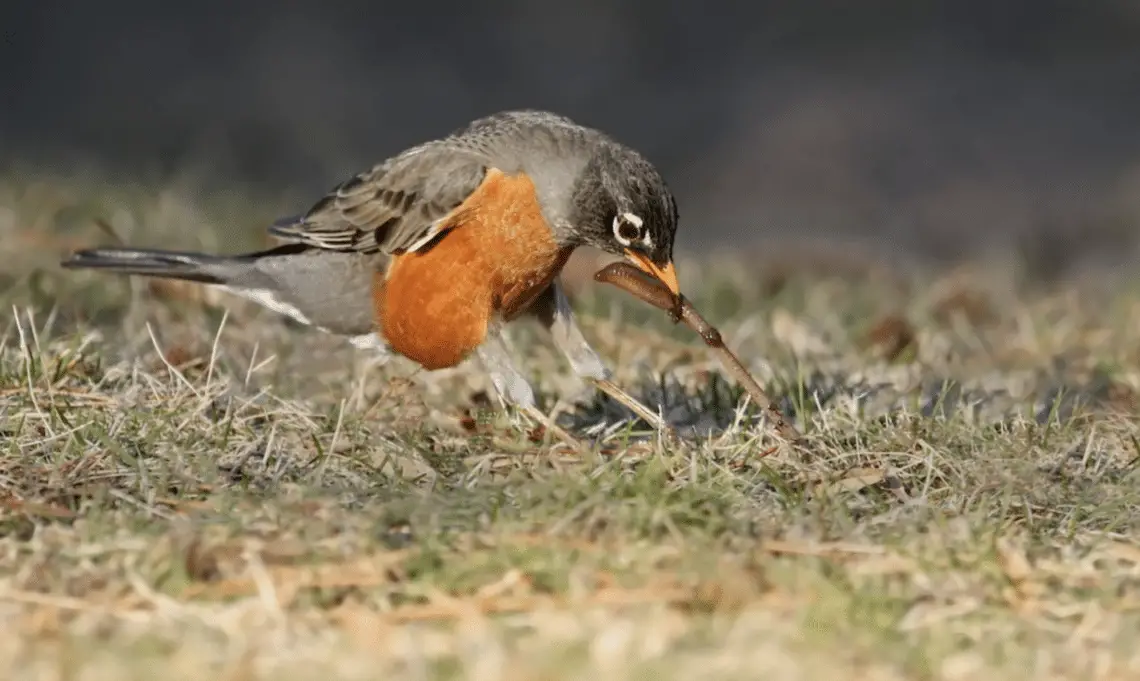
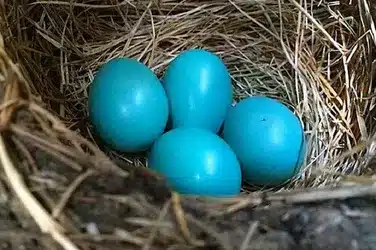
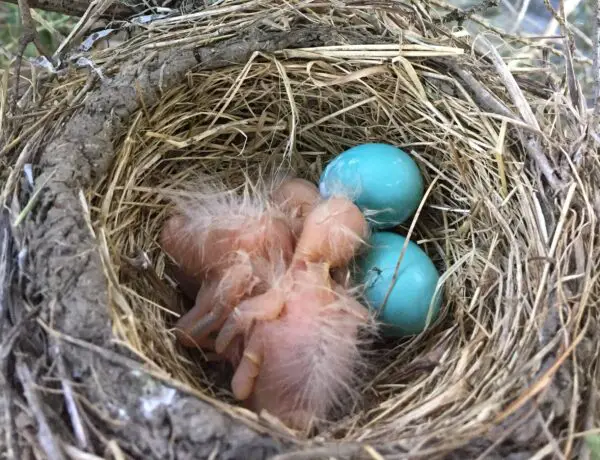
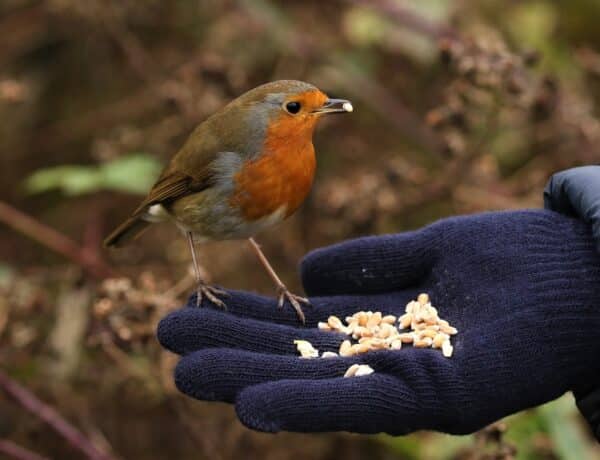
No Comments